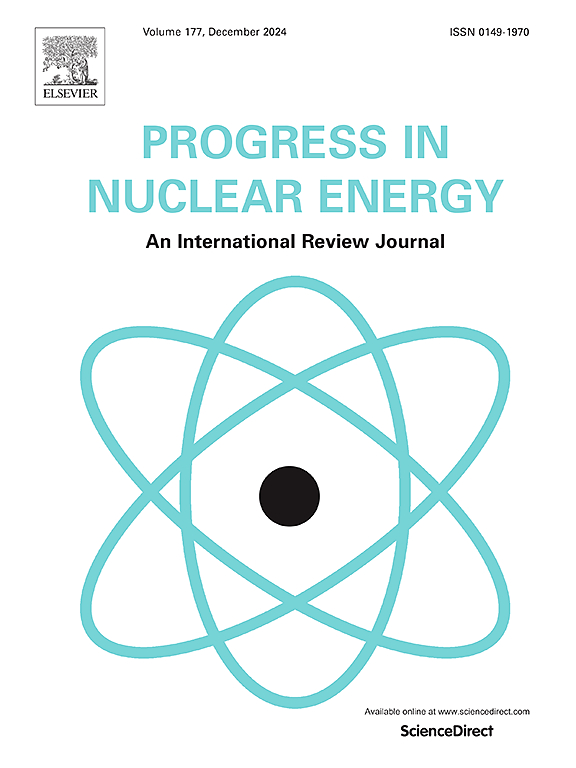带海水淡化的核可再生混合能源系统的经济竞争力:案例研究
IF 3.2
3区 工程技术
Q1 NUCLEAR SCIENCE & TECHNOLOGY
引用次数: 0
摘要
核能和可再生能源混合系统可能是100%清洁能源(非温室气体排放源)组成的电力系统的一种选择。文献中提出的混合系统表明,反应堆在100%的容量下工作,而相关的工业过程和能源存储单元使用的是发电所不需要的能源。目前的案例研究提出了一个100%的混合能源系统,由可再生可变能源(风能和光伏)、小型模块化反应堆和相关的反渗透海水淡化过程组成,其中反应堆将在负荷跟随电力需求模式下工作。墨西哥的一个实际的隔离电力系统由老化的化石燃料、风能和光伏发电厂组成,包括拟议的案例研究。这个地区正遭受缺水之苦。老化的化石工厂被小型模块化反应堆取代,并配有相关的反渗透工厂系统,以缓解水资源短缺。该案例研究考虑了该地区季节性和每日电力需求的实际变化。结果是预期的,可再生能源装机容量渗透率为22.48%;混合动力系统可以满足电力需求。假设电力销售价格为100美元/兆瓦时,该地区的饮用水价格为1.70美元/立方米,拟议的混合系统在投资贴现率高达7%的情况下具有经济竞争力。研究表明,在最坏情况下,负荷跟踪程序不会影响核部件的寿命,并确保整个小型模块化反应堆机组的正常核运行条件。所得结果为这两种类型的混合动力系统提供了一定的制导条件。本文章由计算机程序翻译,如有差异,请以英文原文为准。

Economic competitiveness of a nuclear-renewable hybrid energy system with water desalination: case of study
Nuclear-renewable hybrid systems could be an option for electricity systems composed of 100 % clean sources (non-GHG emitting sources). The proposed hybrid systems in the literature show reactors working at 100 % capacity where associated industrial processes and energy storage units are using energy not required for electricity generation. The current case study proposes a 100 % hybrid energy system composed of renewable variable sources (wind and photovoltaic), small modular reactors, and an associated reverse osmosis desalination process, where the reactors will work in a load-following electricity demand mode. An actual isolated electricity system in Mexico composed of aging fossil fuels, wind, and photovoltaic power plants comprises the proposed case study. This region is suffering from water stress. The aging fossil plants are replaced with small modular reactors with an associated reverse osmosis plant system to alleviate water scarcity. The case study considers actual changes in electricity demand on the region's seasonal and daily basis. Results are promissory, having a variable renewable installed capacity penetration of 22.48 %; the hybrid system can follow electricity demand. The proposed hybrid system is economically competitive for investment discount rates up to 7 %, assuming an electricity selling price of 100 US$/MWh and a potable water price, in the region, of 1.70 US$/m3. The study shows that the load-following procedure, in the worst-case scenario, does not compromise the lifetime of nuclear components and ensures normal nuclear operation conditions in the whole fleet of small modular reactors. The results obtained set some guidance conditions for these types of hybrid systems.
求助全文
通过发布文献求助,成功后即可免费获取论文全文。
去求助
来源期刊

Progress in Nuclear Energy
工程技术-核科学技术
CiteScore
5.30
自引率
14.80%
发文量
331
审稿时长
3.5 months
期刊介绍:
Progress in Nuclear Energy is an international review journal covering all aspects of nuclear science and engineering. In keeping with the maturity of nuclear power, articles on safety, siting and environmental problems are encouraged, as are those associated with economics and fuel management. However, basic physics and engineering will remain an important aspect of the editorial policy. Articles published are either of a review nature or present new material in more depth. They are aimed at researchers and technically-oriented managers working in the nuclear energy field.
Please note the following:
1) PNE seeks high quality research papers which are medium to long in length. Short research papers should be submitted to the journal Annals in Nuclear Energy.
2) PNE reserves the right to reject papers which are based solely on routine application of computer codes used to produce reactor designs or explain existing reactor phenomena. Such papers, although worthy, are best left as laboratory reports whereas Progress in Nuclear Energy seeks papers of originality, which are archival in nature, in the fields of mathematical and experimental nuclear technology, including fission, fusion (blanket physics, radiation damage), safety, materials aspects, economics, etc.
3) Review papers, which may occasionally be invited, are particularly sought by the journal in these fields.
 求助内容:
求助内容: 应助结果提醒方式:
应助结果提醒方式:


